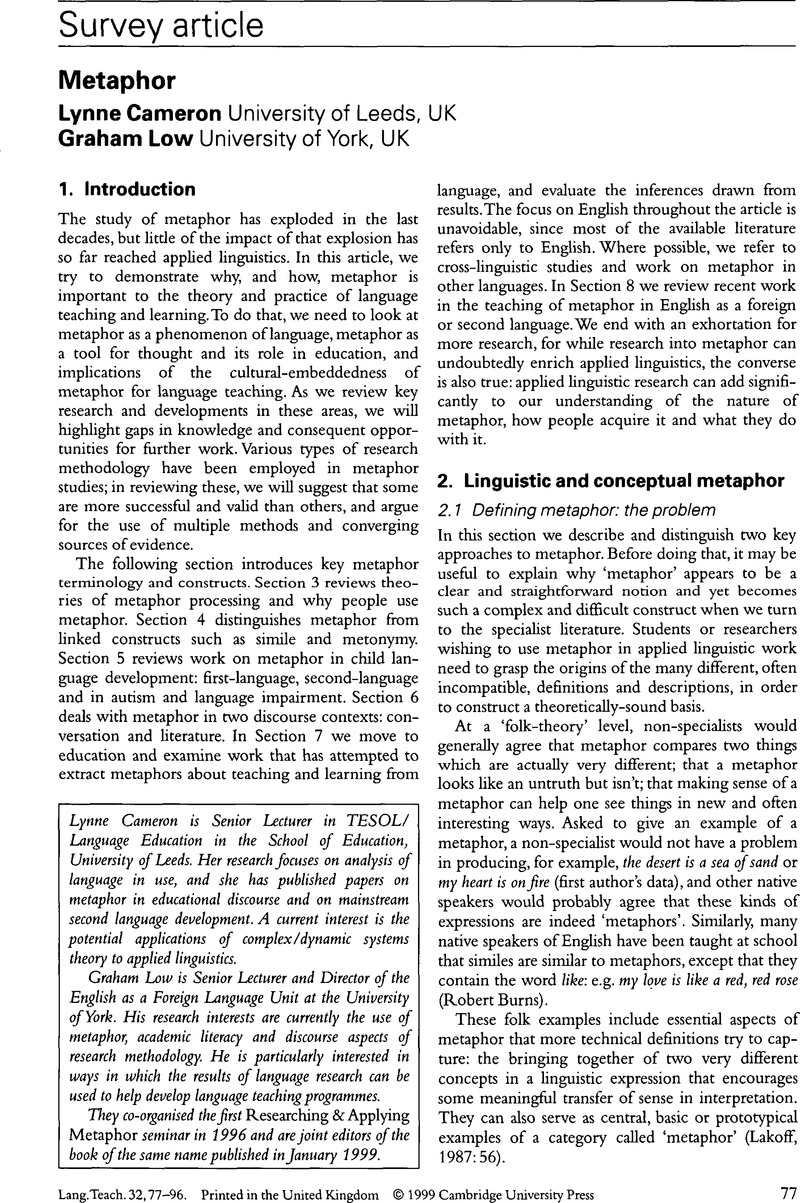Crossref Citations
This article has been cited by the following publications. This list is generated based on data provided by Crossref.
Harris, Jennifer
1970.
La metáfora en los museos de historia social.
Complutum,
Vol. 26,
Issue. 2,
p.
121.
Henderson, Willie
2000.
Metaphor, economics and ESP: some comments.
English for Specific Purposes,
Vol. 19,
Issue. 2,
p.
167.
Steen, Gerard
2000.
Book Review: Metaphor and language and literature: a cognitive perspective.
Language and Literature: International Journal of Stylistics,
Vol. 9,
Issue. 3,
p.
261.
Low, Graham
and
Cameron, Lynne
2002.
Applied-linguistic comments on metaphor identification.
Language and Literature: International Journal of Stylistics,
Vol. 11,
Issue. 1,
p.
84.
Koller, Veronika
2002.
"A Shotgun Wedding": Co-occurrence of War and Marriage Metaphors in Mergers and Acquisitions Discourse.
Metaphor and Symbol,
Vol. 17,
Issue. 3,
p.
179.
de Guerrero, María C. M.
and
Villamil, Olga S.
2002.
Metaphorical conceptualizations of ESL teaching and learning.
Language Teaching Research,
Vol. 6,
Issue. 2,
p.
95.
Boers, Frank
2003.
Applied Linguistics Perspectives on Cross-Cultural Variation in Conceptual Metaphor.
Metaphor and Symbol,
Vol. 18,
Issue. 4,
p.
231.
Low, Graham
2003.
Validating Metaphoric Models in Applied Linguistics.
Metaphor and Symbol,
Vol. 18,
Issue. 4,
p.
239.
White, Michael
2003.
Metaphor and economics: the case of growth.
English for Specific Purposes,
Vol. 22,
Issue. 2,
p.
131.
Caballero Rodriguez, M.d.R.
2003.
How to talk shop through metaphor: bringing metaphor research to the ESP classroom.
English for Specific Purposes,
Vol. 22,
Issue. 2,
p.
177.
Charteris-Black, Jonathan
2003.
Speaking With Forked Tongue: A Comparative Study of Metaphor and Metonymy in English and Malay Phraseology.
Metaphor and Symbol,
Vol. 18,
Issue. 4,
p.
289.
Villamil, Olga S.
and
de Guerrero, Maria C. M.
2005.
Applied Linguistics and Language Teacher Education.
Vol. 4,
Issue. ,
p.
79.
Velasco Sacristán, María Sol
2005.
A critical cognitive-pragmatic approach to advertising gender metaphors.
Intercultural Pragmatics,
Vol. 2,
Issue. 3,
Steen, Gerard
2006.
Metaphor in applied linguistics: four cognitive approaches.
DELTA: Documentação de Estudos em Lingüística Teórica e Aplicada,
Vol. 22,
Issue. spe,
p.
21.
Boers, Frank
and
Lindstromberg, Seth
2006.
Cognitive Linguistics: Current Applications and Future Perspectives.
p.
305.
Zapata, Gabriela C.
and
Lacorte, Manel
2007.
Preservice and Inservice Instructors' Metaphorical Constructions of Second Language Teachers.
Foreign Language Annals,
Vol. 40,
Issue. 3,
p.
521.
Low, Graham
2008.
The Cambridge Handbook of Metaphor and Thought.
p.
212.
Siek-Piskozub, Teresa
and
Strugielska, Ariadna
2008.
Autonomy, Experience and Concepts: A Study in Educational Discourses.
Poznań Studies in Contemporary Linguistics,
Vol. 44,
Issue. 4,
Paulson, Eric J.
and
Armstrong, Sonya L.
2011.
Mountains and Pit Bulls: Students' Metaphors for College Transitional Reading and Writing.
Journal of Adolescent & Adult Literacy,
Vol. 54,
Issue. 7,
p.
494.
Armstrong, Sonya L.
Davis, Hope Smith
and
Paulson, Eric J.
2011.
The Subjectivity Problem: Improving Triangulation Approaches in Metaphor Analysis Studies.
International Journal of Qualitative Methods,
Vol. 10,
Issue. 2,
p.
151.



